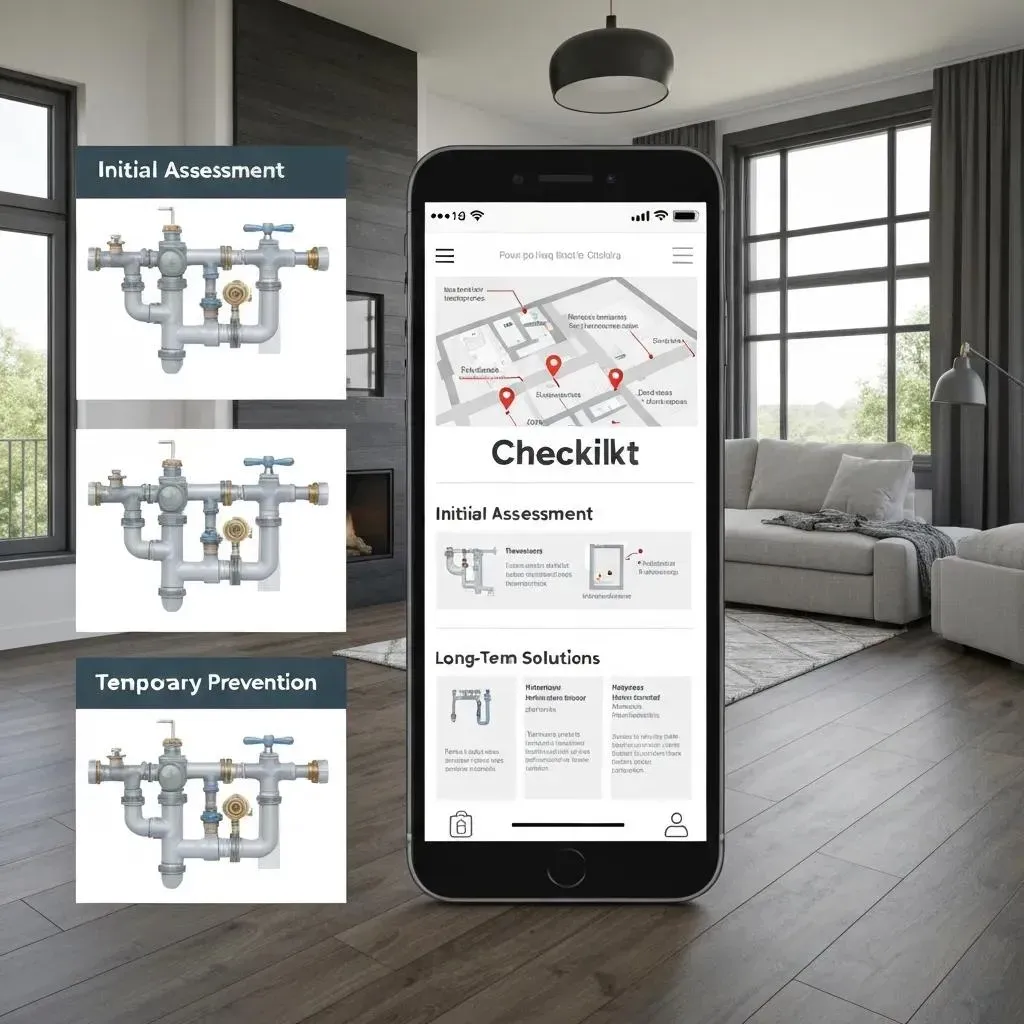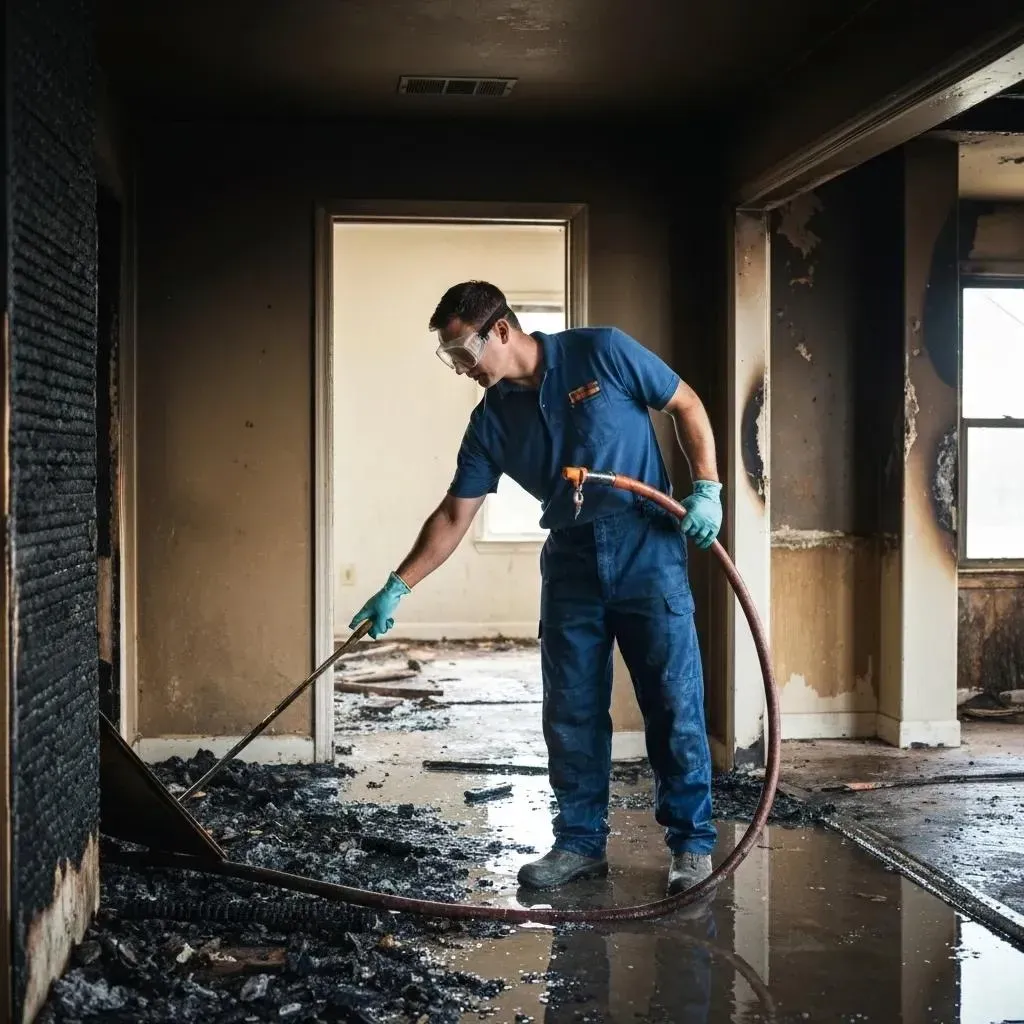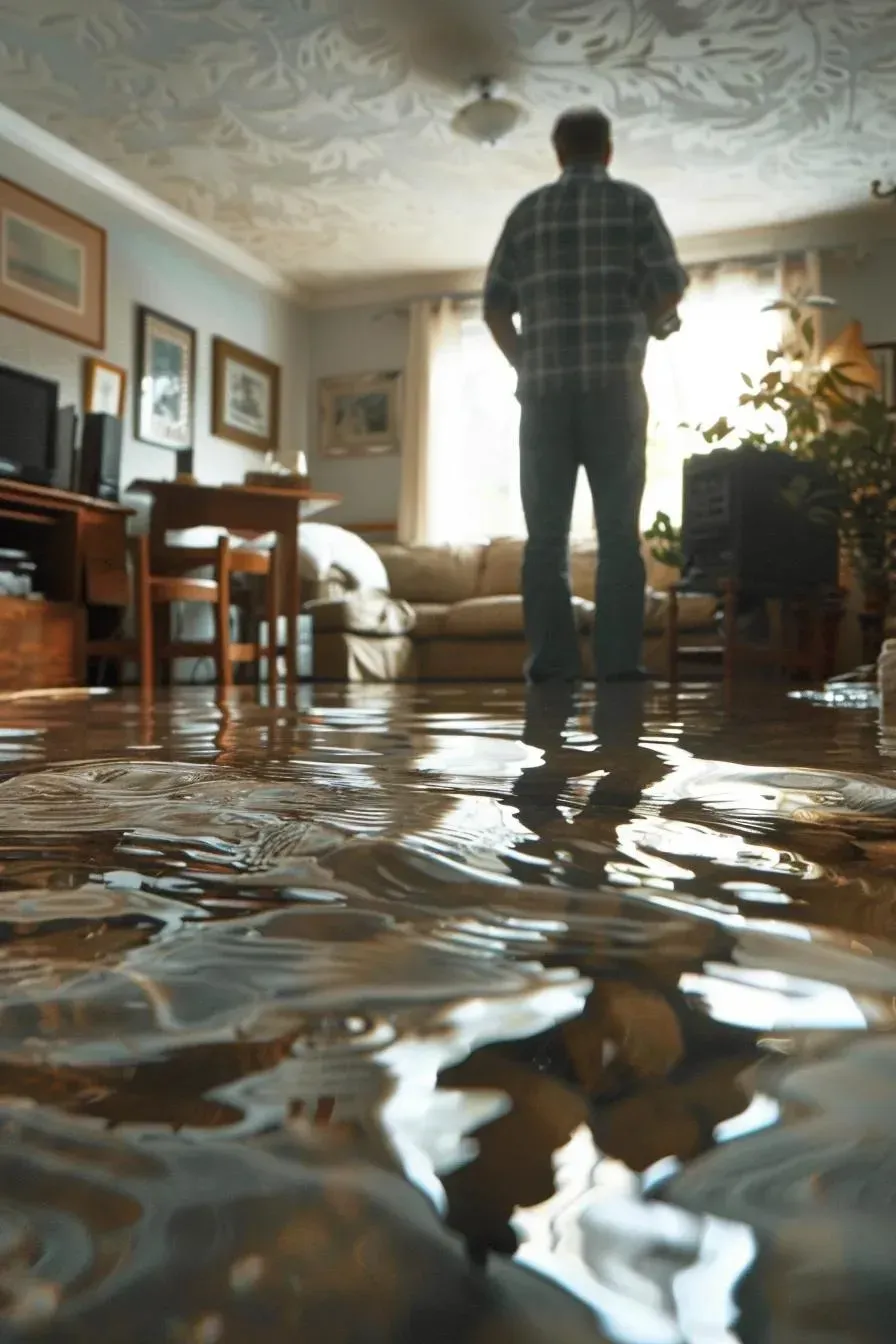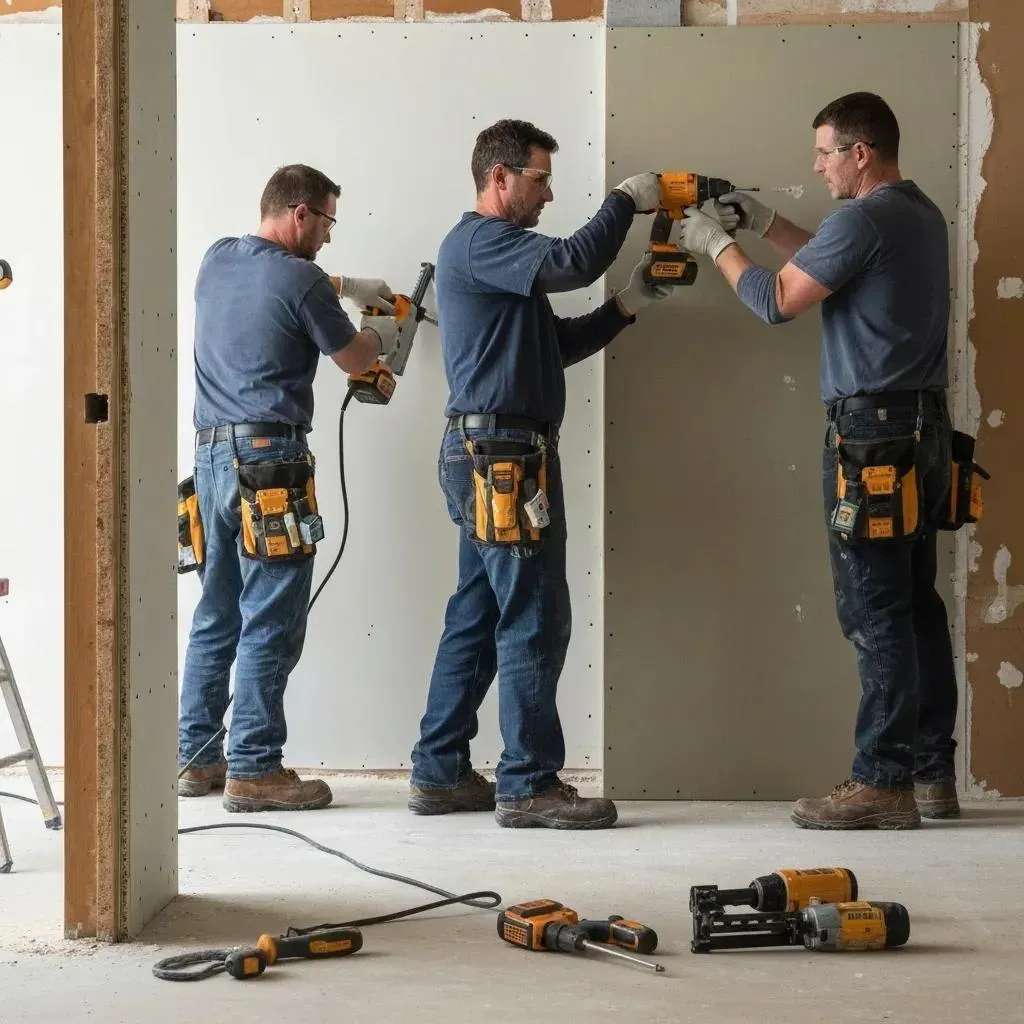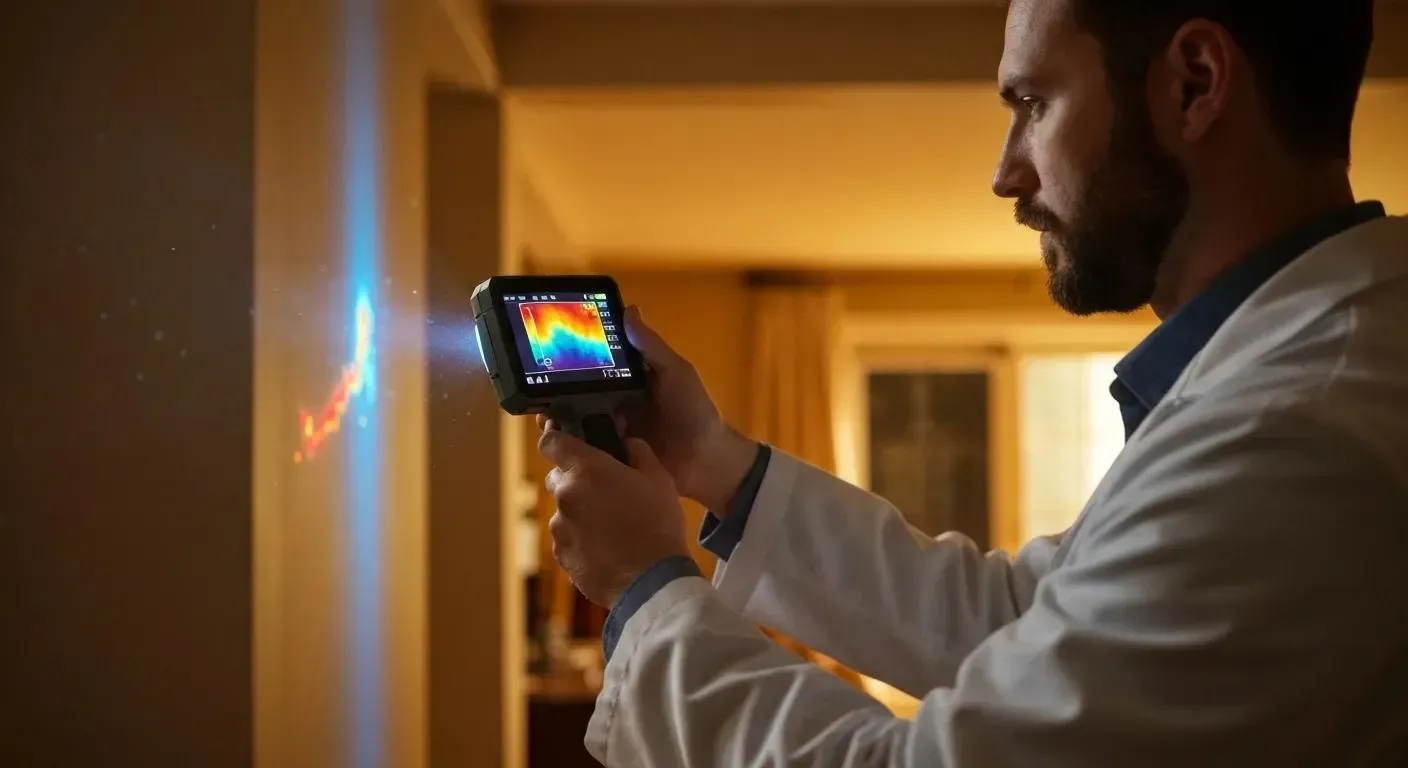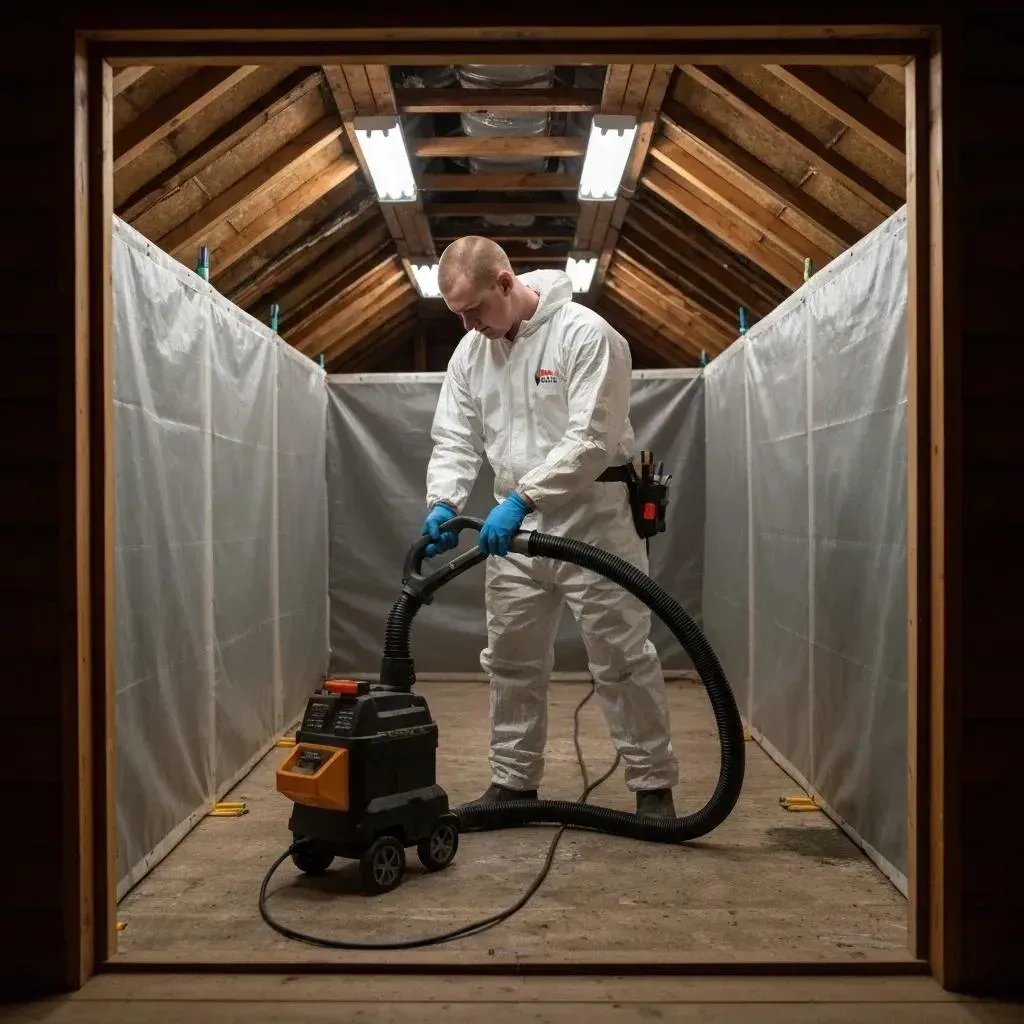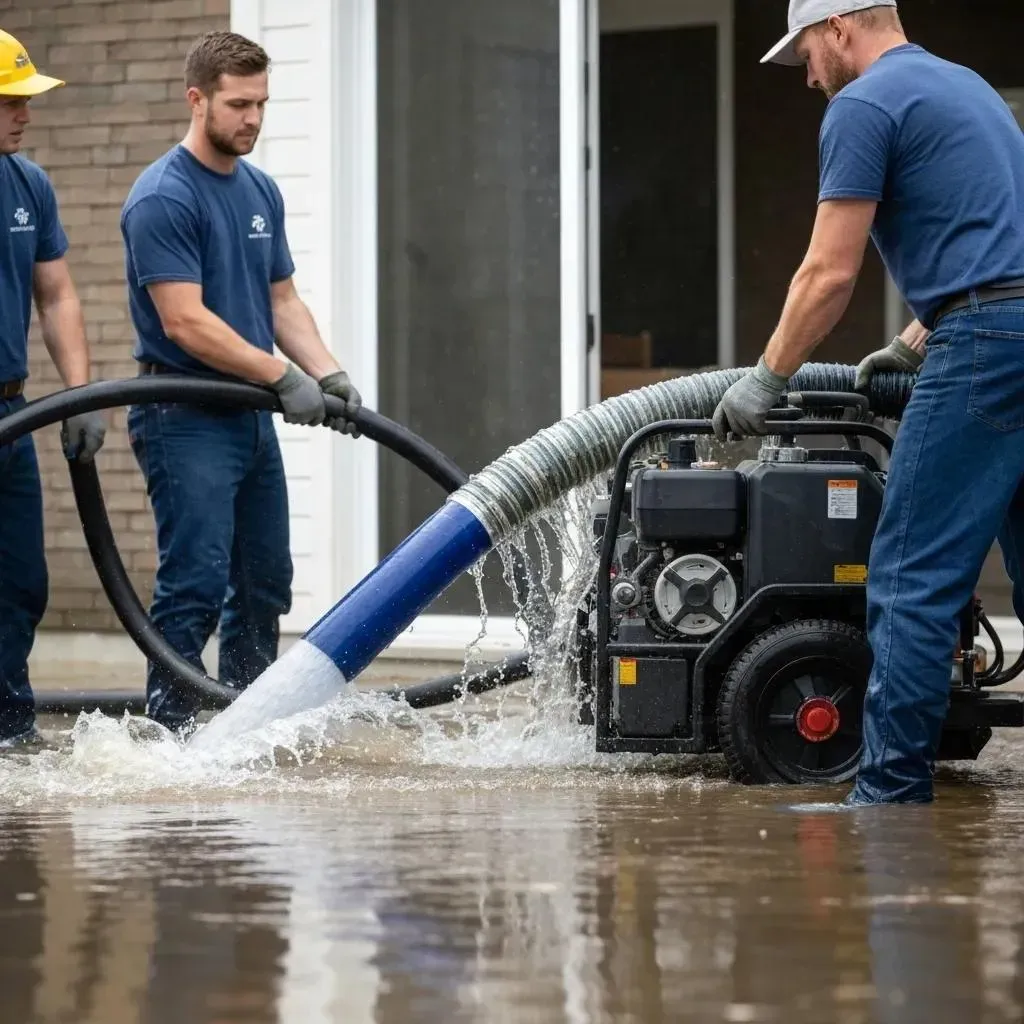Blog
Understanding the Time-Critical Nature of Mold Prevention
Water damage mold prevention is a race against time that every homeowner should be prepared to win. To quickly address the search intent:
Quick Guide to Prevent Mold After Water Damage:
- Act within 24-48 hours- Mold begins growing in this window
- Remove standing water immediately using pumps or wet vacuums
- Dry all affected areas with fans and dehumidifiers
- Maintain indoor humidity between 30-50%
- Remove wet porous materials(carpet padding, insulation) that can't be dried
- Clean and disinfect surfaces with appropriate cleaners
- Monitor moisture levels until completely dry
- Call professionals for areas larger than 10 square feet
When water invades your home – whether from a burst pipe, flooding, or high humidity – the clock starts ticking immediately. Mold spores, which are always present in the air, only need moisture, warmth, and an organic food source to begin colonizing your home. Without swift action, these microscopic invaders can establish themselves in as little as 24 hours.
The Environmental Protection Agency emphasizes that water-damaged materials should be dried and/or removed within 48 hours to minimize mold growth. This narrow window means that understanding proper water damage mold prevention techniques isn't just helpful – it's essential.
Colorado's unique climate presents its own challenges. While our typically dry air might seem advantageous, it can create a false sense of security. Once water intrusion occurs, our homes can quickly create the perfect microclimate for mold growth, especially in enclosed spaces.
I'm Mike Martinez, owner of Accountable Home Services, and I've helped countless Denver homeowners recover from water damage and implement effective water damage mold prevention strategies throughout the Front Range.
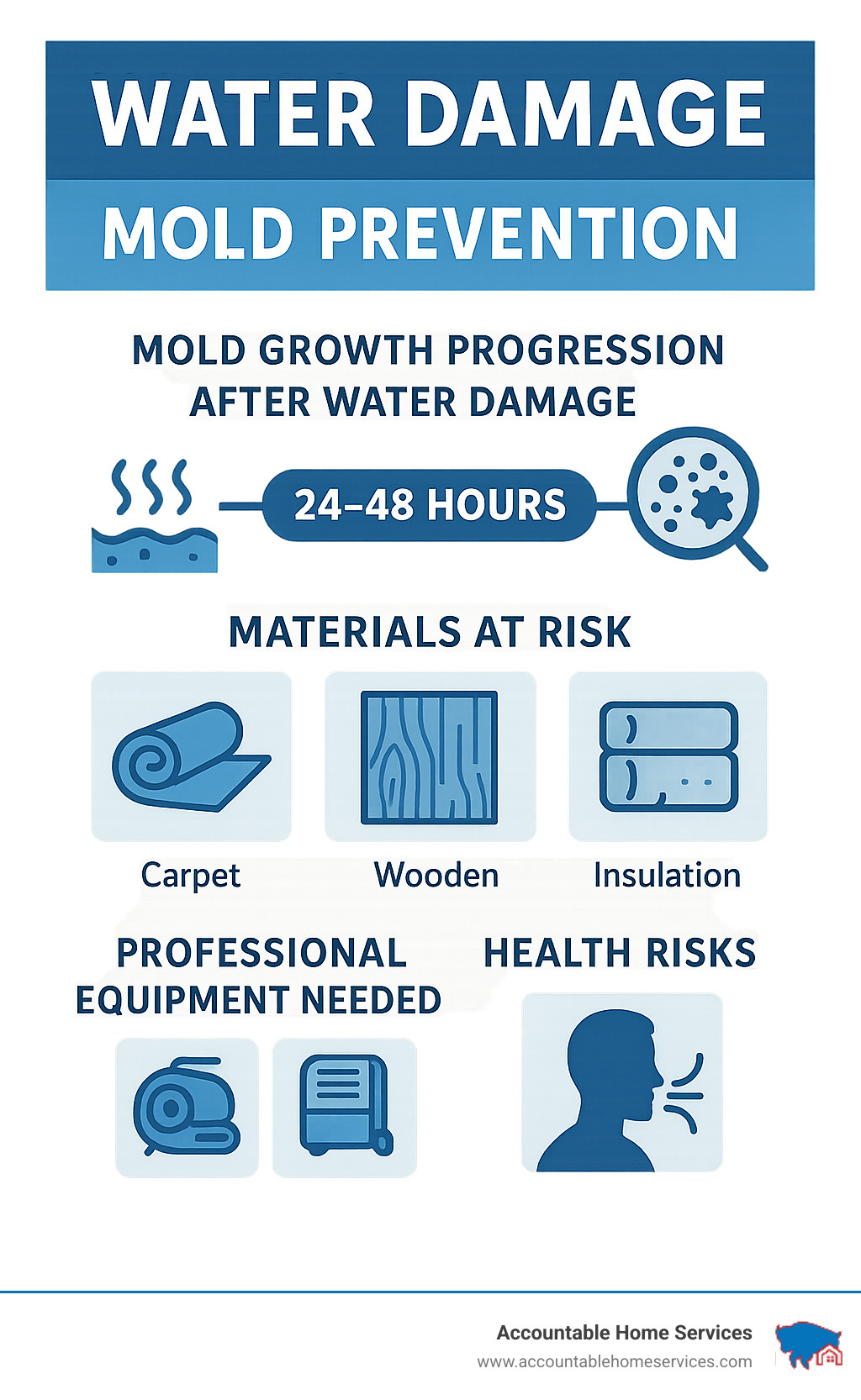
The 24–48-Hour Rule: Why Every Minute Counts
When it comes to water damage mold prevention, understanding the urgency isn't just about following guidelines—it's about respecting biology. Those first 48 hours aren't arbitrary; they represent the critical window before your minor water issue morphs into a full-blown mold infestation.
Mold spores are nature's opportunists. They're always floating around your home, just waiting for the perfect conditions to settle down and multiply. The EPA's 48-hour guideline exists because scientific research consistently shows this is the make-or-break timeframe for effective water damage mold prevention.
What happens when water soaks into your drywall, flooring, or furniture? It creates a perfect storm for mold growth by activating dormant spores, providing essential moisture, breaking down materials into a food source, and creating humid pockets where mold can thrive undisturbed.
The health risks of waiting too long aren't something to gamble with. Mold produces allergens, irritants, and sometimes mycotoxins that can trigger everything from sneezing fits to serious respiratory problems.
How Quickly Can Mold Start After Water Damage?
The countdown begins immediately after water exposure. Under typical conditions, visible mold appears within 24-48 hours, but several factors can speed up this timeline.
Warm temperatures between 77°F and 86°F are like a cozy incubator for mold. Higher humidity levels act like a growth accelerator. And if you're dealing with hot water damage? That can kick mold into high gear, sometimes producing visible growth in just 24 hours.
The materials in your home also play a role. Your carpet, drywall, and wooden structures are essentially mold buffets when wet. And if your home already had a higher concentration of mold spores before the water event, you're looking at an even faster growth timeline.
Here in Denver, we've seen countless cases where homeowners were shocked by how quickly mold established itself after water damage. Even during our dry winters, heated homes with water damage create perfect mold nurseries. Those cozy 70-degree indoor temperatures that feel so good to us feel even better to mold.
Water Damage Mold Prevention First Response Checklist
When water invades your home, those first few hours are make-or-break for preventing mold. I've seen how quick action can save Denver homeowners thousands in remediation costs.

Hitting the Ground Running: Water Damage Mold Prevention Basics
Safety always comes first. Before you splash into action, cut the power to affected areas. Water and electricity create a deadly combination.
Next, gear up properly. Pull on rubber gloves, strap on a proper N-95 respirator, and wear goggles without ventilation holes. Wear clothes you can either wash thoroughly or toss afterward.
Before moving a single item, document everything with photos and videos for insurance claims. Then stop the water at its source. If you're dealing with plumbing issues, shut off your main water valve. For roof leaks, temporary tarps can help. Facing flooding? Sandbags might be your best friend until the water recedes.
Standing water is mold's best invitation to move in. For small areas, a wet/dry vacuum works wonders. Larger floods might require renting professional-grade extraction equipment. When the situation feels overwhelming, call us at Accountable Home Services.
Don't forget to move wet furniture to dry areas and pull up soaked rugs and carpet padding immediately. For items that must stay, lift them on blocks to prevent further absorption.
Prioritize Clean vs. Dirty Water
The type of water in your home makes a massive difference in your cleanup approach. We categorize water damage into three types:
| Water Category | Description | Examples | Response Required |
|---|---|---|---|
| Clean Water (Category 1) | Sanitary source, poses no health risk | Broken water supply lines, tub overflows, appliance leaks with clean water | DIY cleanup possible with proper precautions |
| Gray Water (Category 2) | Contains contaminants, may cause discomfort or illness | Washing machine overflow, toilet overflow with urine, dishwasher leaks | Use protective gear, sanitize thoroughly, consider professional help |
| Black Water (Category 3) | Highly contaminated, contains pathogens | Sewage backups, flooding from rivers/streams, toilet overflow with feces | Professional remediation required, extreme caution needed |
If you're dealing with Category 1 water from a clean source, you can typically handle the cleanup yourself with proper precautions. But when it comes to Category 2 or 3 water, the stakes rise dramatically, making professional intervention crucial.
How can you tell what you're dealing with? Trust your senses. Water damage mold prevention gets more complicated when you notice discoloration in the water, detect foul odors, or know the source is sewage or external flooding.
Drying & Dehumidification: Equipment, Placement, Success Metrics
Proper drying is the cornerstone of effective water damage mold prevention. Even after you've mopped up the visible water, hidden moisture remains trapped in your walls, floors, and furnishings—silently setting the stage for mold growth unless properly addressed.

Sizing Gear for Effective Water Damage Mold Prevention
For air movement, professional-grade air movers deliver 1,000-3,000 CFM (cubic feet per minute), creating the powerful airflow needed to evaporate trapped moisture. A good rule of thumb is placing one air mover per 150-300 square feet of affected area. Position these at 45-degree angles to walls to create a circular airflow pattern. Household box fans simply can't generate this kind of focused airpower.
When it comes to dehumidifiers, Low Grain Refrigerant (LGR) models are your best friends. For a small room up to 300 square feet, you'll want at least a 30-50 pint capacity unit. Medium rooms need 50-60 pint capacity, while larger spaces require 70+ pint machines. The professional units we use pull 70-150 pints daily—that's 3-4 times more effective than typical retail models.
Don't forget about moisture meters—they're essential for tracking your progress. Pin-type meters give you direct readings from materials like wood and drywall, while pinless models allow for non-invasive scanning across surfaces.
How to Properly Dry Walls, Floors & Hidden Cavities
For walls, start by removing baseboards to allow airflow behind the drywall. If you're dealing with significant water intrusion, drilling small ventilation holes at floor level can make a world of difference in drying wall cavities. Wet insulation must come out—it simply cannot be effectively dried in place.
Flooring presents its own challenges. Hardwood floors benefit from specialized floor mats connected to extraction equipment. With carpeting, you'll need to remove and replace the padding, though the carpet itself can often be saved if dried properly. Laminate and vinyl flooring frequently trap water underneath, requiring removal to prevent mold. And concrete might look dry on the surface but can hold moisture for weeks.
The trickiest areas are the hidden spaces you can't see. We use infrared cameras to detect concealed moisture pockets. Make sure to check inside electrical outlets (with power off), under cabinets, behind appliances, and monitor humidity in adjacent rooms and floors.
Your success metrics are specific: wood materials should reach below 16% moisture content, drywall should register between 7-10%, and concrete or masonry should test below 15%. Your ambient relative humidity target should be 30-50%.
One crucial tip: shut down your HVAC system until you're certain it hasn't been contaminated. Your ductwork can quickly become a superhighway for mold spores.
If you're feeling overwhelmed by the equipment needs or technical measurements, our water damage restoration team comes fully equipped with commercial-grade drying equipment specifically calibrated for Denver's unique climate conditions.
Cleaning, Disinfection & Material Decisions
Once the drying process is well underway, proper cleaning and disinfection become crucial for water damage mold prevention. This step eliminates microscopic spores and creates an environment hostile to mold growth.
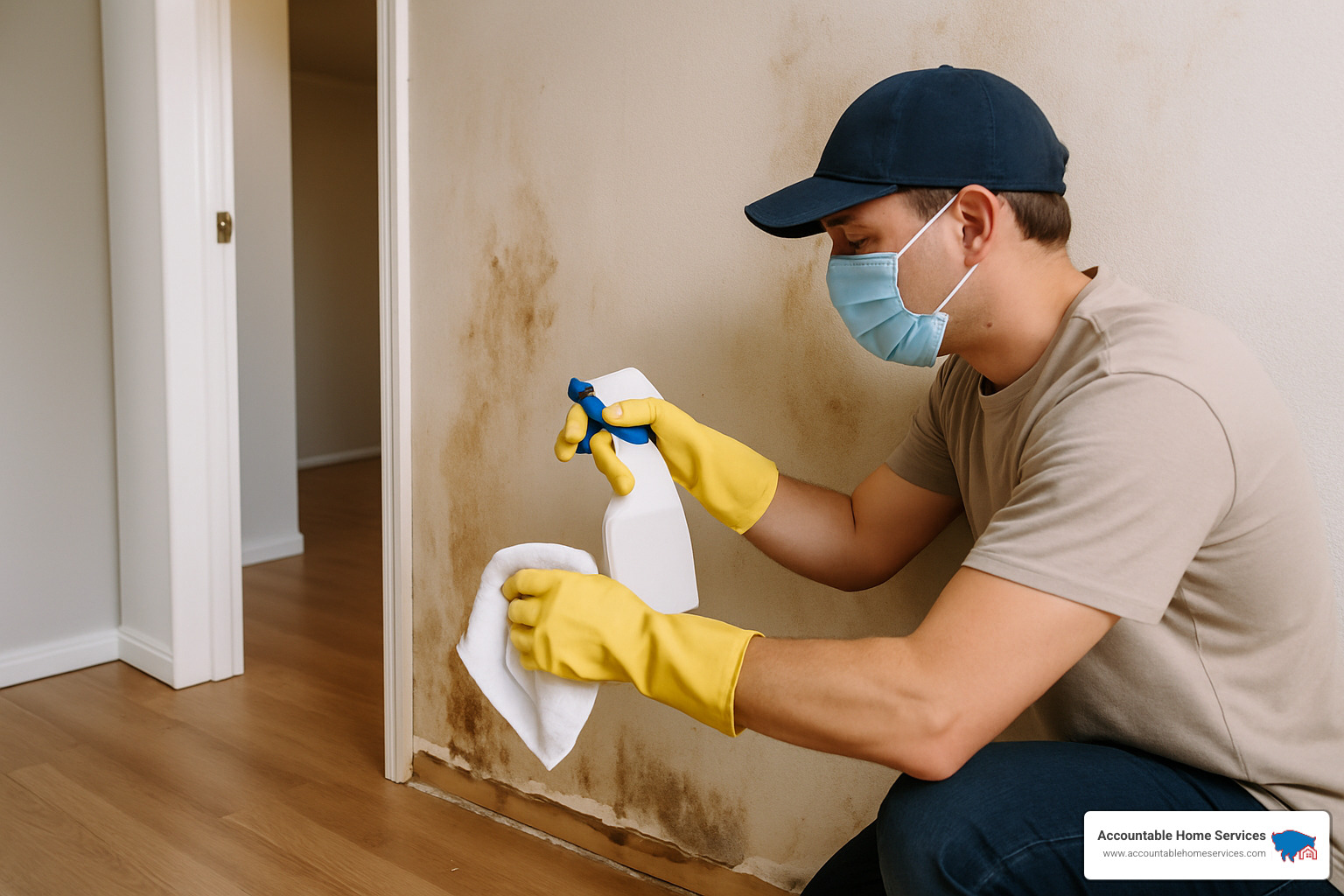
When to Tear-Out vs. Treat
Making the right decisions about materials can save you thousands in future remediation costs. I've seen many Denver homeowners struggle with these choices, often erring on the side of trying to save materials that should really be removed.
Always Remove wet carpet padding, saturated insulation, wet particle board or pressed wood products, and anything touched by black water (Category 3). These items simply cannot be effectively dried or cleaned.
When you're on the fence about certain materials, consider the 48-hour rule. Materials wet for more than two days present significantly higher risks. If you spot visible mold growth exceeding 10 square feet, that's another clear sign removal is necessary. Structural compromise is another deal-breaker – if it's sagging, warping, or buckling, it needs to go.
On the brighter side, some materials can often be saved with prompt action. Solid wood furniture and trim can usually be salvaged if dried within 48 hours. Drywall with minimal water exposure (less than 24 hours) often responds well to proper drying techniques. Carpet exposed only to clean water can sometimes be professionally cleaned and restored. Concrete and masonry surfaces are typically salvageable after thorough disinfection.
For more detailed information on professional approaches to mold remediation, check out our Mold Removal and Remediation services page.
Safe Use of Cleaning Agents
A simple detergent and water solution works well for initial cleaning of most surfaces. For more thorough disinfection, commercial anti-microbial products are effective when used according to label instructions. For non-porous surfaces, a bleach solution (1 cup household bleach per gallon of water) can be very effective at killing mold spores.
Safety is paramount when using these cleaning agents. Never mix cleaning products – especially bleach and ammonia, which creates a toxic gas that can be deadly. Always ensure adequate ventilation by opening windows and using fans when cleaning. Wear appropriate PPE (gloves, mask, eye protection) to protect yourself from both the cleaning agents and potential mold spores.
When it comes to application, scrubbing hard surfaces with a stiff brush and your chosen cleaning solution is the most effective approach. After cleaning, apply disinfectants and allow proper dwell time – many people rush this step, which reduces effectiveness.
For homes with family members who have respiratory conditions, compromised immune systems, or chemical sensitivities, gentler options like hydrogen peroxide-based products or EPA-registered botanical disinfectants can be good alternatives.
Monitoring, Documentation & Professional Help Triggers
Winning the battle against mold doesn't end when the fans shut off. Successful water damage mold prevention requires staying vigilant even after the initial cleanup seems complete.
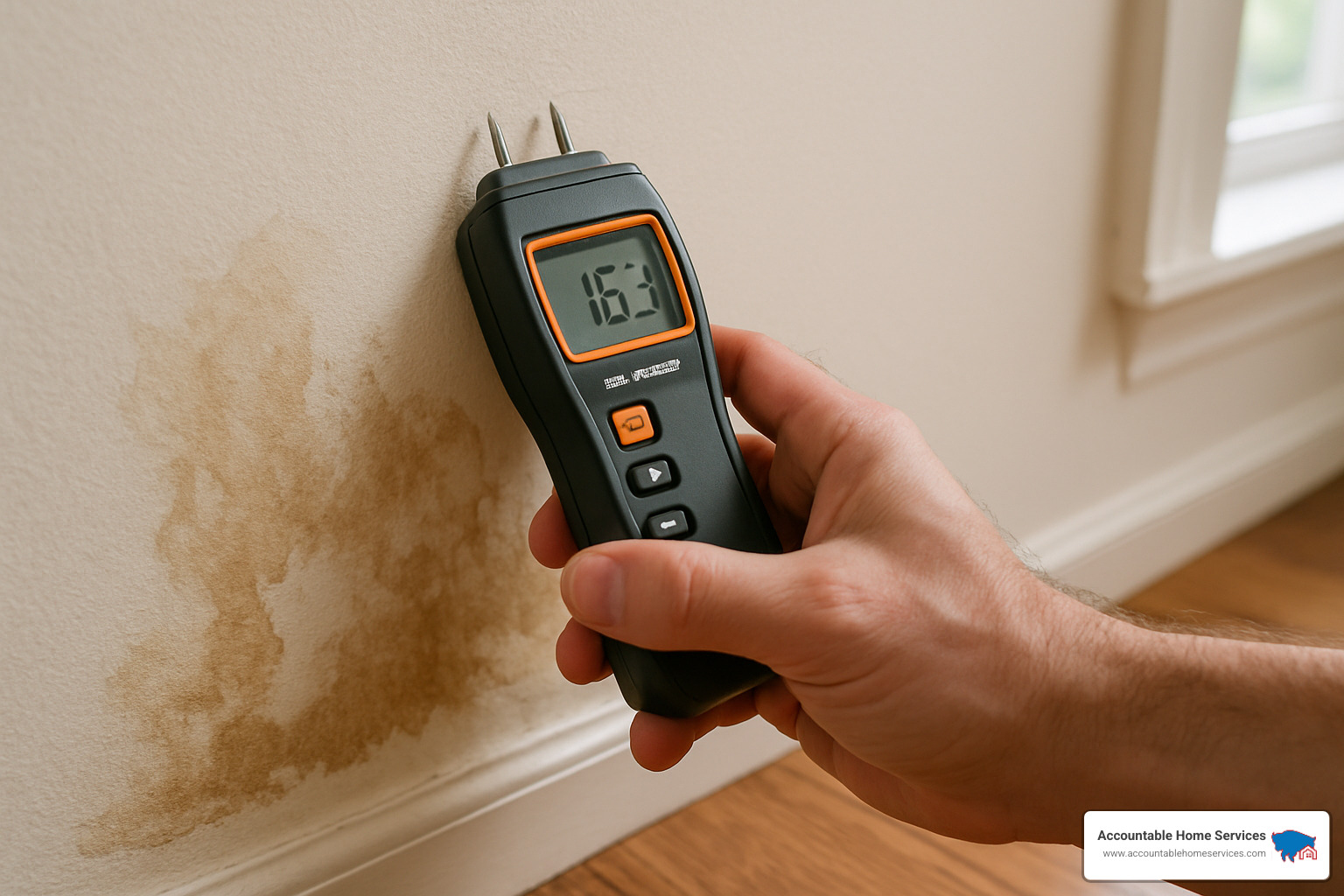
We've found that homeowners who follow a simple monitoring routine dramatically improve their success rates. Take daily moisture readings of affected materials, record both the readings and the ambient temperature and humidity, and snap photos as you go. Keep at it until your materials reach those target moisture levels we discussed earlier.
Here in Denver's unique climate, we often see dramatic day-to-night humidity swings that can affect drying times. That's why at Accountable Home Services, we provide our clients with detailed monitoring reports documenting the entire process.
Signs Mold Is Already Present After Water Damage
Sometimes, despite your best efforts, mold finds a way. Knowing the warning signs can help you catch problems early:
Your eyes might spot discoloration on surfaces ranging from black to green or even white patches. Look for warping or bubbling of materials, water stains that change appearance, or any visible growth, even tiny spots.
Often, your nose knows first—that distinctive musty, earthy odor is frequently the earliest sign of hidden mold. Pay attention if family members experience increased allergy symptoms when in certain areas of your home. Notice persistent dampness despite your drying efforts? That's a red flag. So is peeling paint or wallpaper that suddenly starts to separate from walls.
I always teach Denver homeowners the simple "touch test"—press your finger against a suspicious surface, and if it feels cool or damp, moisture is likely lingering there, creating a perfect mold nursery.
When to Call a Pro for Water Damage Mold Prevention
While many of our Denver neighbors successfully handle small water incidents, certain situations call for professional reinforcements.
It's time to pick up the phone when the affected area exceeds 10 square feet (about the size of a small area rug). Don't hesitate if you're dealing with contaminated water from sewage backups or flooding. If water has made its way into your HVAC system, professional help is non-negotiable, as these systems can spread mold spores throughout your entire home.
Those persistent musty odors that linger despite your best drying efforts? That's your home's way of asking for expert help. The same goes for water damage that's affected structural elements like load-bearing walls or floor joists. And please call immediately if you or family members experience unusual health symptoms like persistent coughing, watery eyes, or breathing difficulties when in the affected areas.
At Accountable Home Services, our certified technicians bring specialized equipment and expertise to tackle these challenging scenarios throughout the Denver Metro area, including Westminster, Thornton, Arvada, and Boulder.
Long-Term Strategies to Prevent Mold Returning
After successfully addressing immediate water damage, implementing long-term water damage mold prevention strategies will protect your Denver home from future incidents.

Your home's exterior is your first line of defense against moisture intrusion. Proper landscape grading is essential—make sure the ground slopes away from your foundation, not toward it. Clean gutters regularly and ensure downspouts extend at least 5 feet from your foundation to prevent water pooling.
With Colorado's infamous snow and hail seasons, your roof takes a beating. Inspect and maintain roof flashing regularly, especially around chimneys and vents where leaks commonly start. For properties with recurring drainage issues, a French drain might be worth the investment. And don't forget to seal foundation cracks and apply waterproofing coatings.
Inside your home, maintaining the right humidity level is key. Install humidity monitors in basements and crawl spaces, which can alert you to problems before mold gets a foothold. The sweet spot for indoor relative humidity is between 30-50%—use dehumidifiers if needed to maintain this range, especially during our occasional humid spells.
Those HVAC condensate pans and drain lines that nobody thinks about? They're actually prime spots for mold growth. Regular inspection and cleaning prevents clogs that can lead to water damage.
"The bathroom exhaust fan isn't just for odors," I often tell my clients. "It's a critical tool for water damage mold prevention." Make sure yours vents properly to the exterior—not just into your attic where moisture can become trapped.
Structural improvements can provide long-term protection against mold. Consider installing water leak detection systems near high-risk appliances like washing machines and water heaters. When renovating, choose mold-resistant building materials like paperless drywall, treated lumber, and non-organic flooring options.
Proper attic ventilation is particularly important in our climate, where temperature swings can create condensation issues. A well-ventilated attic prevents the moisture buildup that can lead to mold growth and even structural damage over time.

Professional duct cleaning every 3-5 years can also help prevent mold growth in your HVAC system. This is particularly important if you've experienced water damage in the past, as mold spores can linger in ductwork and spread throughout your home.
At Accountable Home Services, we understand Colorado's unique environmental challenges. Our dry air can sometimes mask humidity problems until they've already caused damage, while our rapid temperature changes create condensation issues that other regions don't experience. We tailor our recommendations to address these regional factors, helping Denver homeowners implement effective long-term water damage mold prevention strategies.
Want to learn more about protecting your home from hidden moisture risks? Check out our detailed guide on How Water Damage Creates Unseen Mold Risks for additional insights specific to Denver homes.
Frequently Asked Questions about Water Damage Mold Prevention
How can I keep indoor humidity low during Denver's humid spells?
Denver might be famous for its dry climate, but we do experience humid periods when moisture control becomes crucial. The sweet spot for indoor humidity is between 30-50%. When levels climb above 60%, you're essentially rolling out the welcome mat for mold growth.
Strategic dehumidifier placement makes all the difference, especially in trouble spots like basements and crawl spaces. Make sure your bathroom and kitchen exhaust fans actually vent outside. Your air conditioning system naturally pulls moisture from the air, so running it during humid spells serves double duty for comfort and mold prevention.
For homes that struggle with consistent humidity control, investing in a whole-house dehumidifier might be worth considering. I also recommend placing humidity monitors in different areas of your home to identify problem zones before they become mold havens.
What PPE is essential for small DIY mold cleanup?
When tackling a small mold cleanup project (less than 10 square feet), proper protection isn't just a suggestion—it's essential for your health. Disturbing mold sends thousands of microscopic spores airborne, which can spread throughout your home.
Start with respiratory protection—a proper N-95 respirator creates the barrier you need against airborne spores. Protect your eyes with goggles that don't have ventilation holes. Your hands need non-porous gloves that extend to mid-forearm. For clothing, either wear something you can immediately wash in hot water or consider disposable coveralls for more extensive projects.
I always tell my Denver clients with respiratory conditions or compromised immune systems to skip the DIY approach entirely. Even small mold remediation projects can trigger health issues for sensitive individuals.
Are dehumidifiers alone enough to stop mold after a minor leak?
While dehumidifiers are valuable tools in your water damage mold prevention arsenal, relying solely on them after a water incident is like trying to empty a bathtub with a teaspoon—possible, but not nearly efficient enough to beat mold's 48-hour growth window.
Dehumidifiers excel at removing moisture from the air, but they don't actively pull water from soaked materials. They simply work too slowly to meet that critical 48-hour drying timeline. Plus, they can't reach moisture trapped inside wall cavities or underneath flooring.
For effective prevention after even a small leak, you need a comprehensive approach. First, remove any standing water completely. Then use air movers strategically placed to evaporate moisture from affected materials. Only then should you deploy dehumidifiers to capture that evaporated moisture from the air. Don't forget to address hidden moisture pockets and continuously monitor levels until materials return to appropriate dryness standards.
Conclusion
When it comes to water damage mold prevention, the difference between a quick recovery and a lengthy, expensive nightmare often comes down to those first crucial hours. That 24-48 hour window isn't just a suggestion—it's your golden opportunity to prevent a simple water incident from morphing into a full-blown mold invasion.
Living in Denver presents its own unique challenges. Our typically dry climate can sometimes fool homeowners into a false sense of security. The truth is, even in our arid environment, hidden moisture in wall cavities, underneath flooring, or tucked away in basements can create perfect little ecosystems for mold to thrive if not properly addressed.
Throughout my years serving homeowners across Westminster, Thornton, Arvada, Boulder, and the entire Denver Metro area, I've seen how proper equipment and quick action can make all the difference. Our team at Accountable Home Services brings industrial-grade equipment and proven techniques to ensure your home gets completely dry—not just surface dry.
If there's one thing I want you to take away from this guide, it's this: don't wait. Every hour counts when water invades your home. Here's what successful water damage mold prevention really comes down to:
- Act within that critical 24-48 hour window
- Use equipment properly sized for your specific situation
- Don't just trust your eyes—use moisture meters to confirm materials are truly dry
- Address both visible water and the moisture you can't see
- Think long-term with prevention strategies that protect your home year-round
Whether you're tackling a small leak yourself or facing major flooding that requires professional help, these principles will guide you toward successful recovery and protection.
I've seen the relief on homeowners' faces when they realize their quick action saved them thousands in repairs. I've also comforted families who waited too long and now face extensive remediation. The difference often comes down to those first few days.
If you're dealing with water damage in your Denver home right now, please don't hesitate to contact us for a free assessment. Our emergency response team is available 24/7, ready to help you prevent mold and protect what matters most—your home and the people in it.
At Accountable Home Services, we're more than just a restoration company. We're your neighbors, your trusted partner, and your advocate for a safe, healthy home—today and for years to come.

